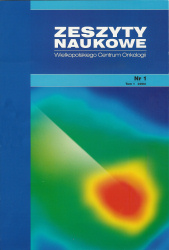Abstract
Breast cancer is a malignant tumor that originates in the mammary gland's cells that grow locally in the breast metastasizes to the lymph nodes and internal organs (lungs, liver, bones and brain). Over 23% of cancer cases in women in Poland and the world are breast cancer. Techniques for irradiating breast cancer have developed continuously in recent years. The study aimed to present the radiotherapeutic techniques used in irradiation of breast cancer - from two-dimensional 2D static to dynamic techniques (IMRT intensity modulated radiation therapy, VMAT volumetric modulated arc therapy) up to DIBH deep inspiration breath hold. The paper focuses on implementing the given techniques and describing the influence of a given technique on the dose distribution in the Planning Target Volume (PTV) and doses in critical organs in breast cancer radiotherapy.
References
Kordek R. Onkologia. Podręcznik dla studentów i lekarzy. Kordek R. (red). Wydawnictwo Medyczne ViaMedica, Gdańsk 2007.
Meder J. Radioterapia nowotworów. Onkologia kliniczna. Krzakowski M. (red). Wydawnictwo Borgis, Warszawa 2006.
Krajowy rejestr nowotworów. http://onkologia.org.pl
Darby S, McGale P, Correa C, et al. Review Effect of radiotherapy after breast-conserving surgery on 10-year recurrence and 15-year breast cancer death: meta-analysis of individual patient data for 10,801 women in 17 randomised trials. Early Breast Cancer Trialists' Collaborative Group (EBCTCG). Lancet. 2011; 378:1707-16,
Bentzen S.M, Constine L.S, Deasy J.O, et al. Quantitative Analyses of Normal Tissue Effects in the Clinic (QUANTEC): An Introduction to the Scientific Issues. Int J Radiat Oncol Biol Phys. 2010;76:3–9.
Ahmad S, Duke S, Jena R, et al. Advances in radiotherapy. BMJ. 2012; 345:65-77.
Siiskonen T, Kaijaluoto S, Florea T, et al. Imaging practices and radiation doses from imaging in radiotherapy. Physica Medica. 2017;42:247-252.
Arthur D , Arnfield M, Warwicke L, et al. Internal mammary node coverage: an investigation of presently accepted techniques. Int J Radiat Oncol Biol Phys 2000;48(1):139-46.
Das I.J. Lung and heart dose volume analyses with CT simulator in radiation treatment of breast cancer. Int J Radiat Oncol Biol Phys 1998;42:11-9.
Pierce L J, Butler J, Martel M K, et al. Postmastectomy radiotherapy of the chest wall: dosimetric comparison of common techniques. Int J Radiat Oncol Biol Phys. 2002;52:1220-30.
Cho B. Intensity-modulated radiation therapy: a review with a physics perspective. Radiat Oncol J. 2018; 36:1–10.
Ziólkowska E, Wisniewski T, Kubiak M, et al. IMRT technique in patients with breast cancer treated with breast conserving therapy - obstacles and advantages. Współczesna Onkologia. 2007;11:475-80.
Yeh H P, Huang Y, Wang L Y, et al. Helical tomotherapy with a complete-directional complete block technique effectively reduces cardiac and lung dose for left-sided breast cancer. Br J Radiol. 2020;93:20190792.
Ma C, Zhang W, Lu J, et al. SU-E-P-56: Dosimetric Comparison of Three Post Modified Radical Mastectomy Radiotherapy Techniques for Locally Advanced Left-Sided Breast Cancer and Beyond. Biomed Res Int. 2020; 2020:7131590.
Sankar A, Velmurugan J. Different intensity extension methods and their impact on entrance dose in breast radiotherapy: A study. J Med Phys. 2009;34:200–05.
Farace P , Zucca S, Solla, et al. Planning hybrid intensity modulated radiation therapy for whole-breast irradiation. Int J Radiat Oncol Biol Phys. 2012; 84:115-22.
Mayo CS, Urie MM, Fitzgerald TJ, et al. Hybrid IMRT plans - concurrently treating conventional and IMRT beams for improved breast irradiation and reduced planning time. Int J Radiat Oncol Biol Phys. 2005;61:922-32.
Virén T, Heikkilä J, Myllyoja K, et al. Tangential volumetric modulated arc therapy technique for left-sided breast cancer radiotherapy. Radiat Oncol. 2015;10:79.
Skrobała A. Czy istnieje „najlepszy” sposób kontroli ruchomości oddechowej pacjenta w trakcie radioterapii?; w świetle doniesień konferencyjnych ASTRO 59, San Diego, USA. Letters in Oncology Science. 2020;17:57-63.
Latty D, Stuart K, Wang W, et al. Review of deep inspiration breath-hold techniques for the treatment of breast cancer. J Med Radiat Sci. 2015; 62:74–81.
Niwińska A, Gałecki J. Current indications and methods of postoperative radiation therapy — repetition before the exam. Oncol Clin Pract. 2016;12:18–24.
Pandeli C, Lloyd M, Smyth M, et al. See Dose reduction to organs at risk with deep-inspiration breath-hold during right breast radiotherapy: a treatment planning study. Radiat Oncol. 2019;14:223.
Vikström J, Hjelstuen M, Mjaaland I, et al. Cardiac and pulmonary dose reduction for tangentially irradiated breast cancer, utilizing deep inspiration breath-hold with audio-visual guidance, without compromising target coverage. Acta oncologica. 2011;50:42-50.
Bergom C, Currey A, Desai N, et al. Deep Inspiration Breath Hold: Techniques and Advantages for Cardiac Sparing During Breast Cancer Irradiation. Front Oncol. 2018;8:87.
Rice L, Goldsmith C, Green M, et al. An effective deep-inspiration breath-hold radiotherapy technique for left-breast cancer: impact of post-mastectomy treatment, nodal coverage, and dose schedule on organs at risk. Breast Cancer (Dove Med Press). 2017;9:437-446.
Arsene-Henry A, Foy J P, Robilliard M, et al. The use of helical tomotherapy in the treatment of early stage breast cancer: indications, tolerance, efficacy—a single center experience. Oncotarget. 2018;9:23608–19.
Mayinger M, Borm K J, Dreher C, et al. Incidental dose distribution to locoregional lymph nodes of breast cancer patients undergoing adjuvant radiotherapy with tomotherapy - is it time to adjust current contouring guidelines to the radiation technique? Radiat Oncol. 2019; 14:135.
Goddu S M, Chaudhari S, Mamalui-Hunter M, et al. Helical tomotherapy planning for left-sided breast cancer patients with positive lymph nodes: comparison to conventional multiport breast technique. Int J Radiat Oncol Biol Phys. 2009;73:1243-51.

This work is licensed under a Creative Commons Attribution-NoDerivatives 4.0 International License.
Copyright (c) 2021 Letters in Oncology Science
